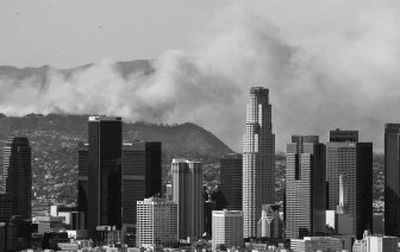Los Angeles anxious about high fire risk

LOS ANGELES – The hills surrounding the famed Hollywood sign are shades of tan, chocolate and gray. Not too far away, other parts of Griffith Park are a wasteland, charred by a wildfire that threatened the Los Angeles Zoo. And just outside the city in windswept Antelope Valley, where the hills are usually awash in indigo, tangerine and magenta this time of year, several dozen sorry-looking poppies are all flower-loving visitors can see.
Los Angeles and many parts of Southern California are suffering through their driest year since recordkeeping began in 1872. And beyond the dramatic proof of the danger of fire, more subtle signs of drought are everywhere.
The rainy season isn’t over yet, but “unless we get some kind of storms on the caliber of biblical in nature, this will be the driest year on record,” said Adam Walden, a senior civil engineer in the water resources division of the Los Angeles County Department of Public Works. For the first time, Los Angeles has received what is normal rainfall for Death Valley.
The Los Angeles Basin receives an average 15.74 inches of rain a year, but will be lucky to make it to the four-inch mark by the end of the season. This spring, many hills never even had a chance to turn from brown to green.
The region is now in an “extreme” drought state, the second-driest ranking bestowed by the National Drought Mitigation Center in Lincoln, Neb. The reservoir behind the Big Dalton Dam, which is flanked by the San Gabriel Mountains near Glendora, is all but empty, the parched earth alongside it cracking in the relentless heat.
Drive beyond the city center, and you’ll see sheep grazing on barren pastures. Deer looking for water in nearly empty reservoirs. And, in some places, bees. Lots of bees.
Two years ago, when there were record high rains, bees established colonies in outlying areas that had been less hospitable before. Now that they’re dry again, the bees are looking for water in Los Angeles suburbs.
The bees, including the aggressive Africanized honeybee, are going “where people have swimming pools, where they’re watering their lawns,” said Ken Pellman, a spokesman for the Los Angeles County agricultural commissioner.
Homeowners are also complaining about rodents and ants on the prowl for water and food. “As berries and nuts dry up, these critters are looking for alternate forms of sustenance and coming into people’s yards,” said Patrick Copps, an entomologist and the Pacific technical manager for Orkin Pest Control.
Ranchers are starting to lament the rainy season that wasn’t, pointing out the dry fields that have kept many heads of cattle uncharacteristically slender.
“There are reports of cattlemen cutting their herds’ sizes back, or having to buy additional feed supplies,” said Brian Fuchs, a climatologist with the National Drought Mitigation Center.
The previous driest year on record was five years ago, with 5.46 inches of rain. As of today, the city has received only about half that, according to the Los Angeles County Department of Public Works.
In late April – typically the peak of wildflower season – there were only about 130 poppies scattered over a three-mile trail in the Antelope Valley California Poppy Reserve. The visitors center, normally bustling with tourists buying poppy-adorned T-shirts and tote bags, has shut for the season, weeks earlier than usual.
Thanks to aggressive water collection and conservation efforts – as well as decent rainfall in the past few years – Angelenos aren’t facing water rationing. And, barring a prolonged drought, experts don’t expect they will.
But the lack of storms this year is especially troubling for fire officials, who fear that Southern California’s fire season could turn out to be unprecedented in both the number and scope of devastating infernos. Cases in point: This month wildfires burned more than 800 acres in Los Angeles’ Griffith Park and more than 4,000 acres on Santa Catalina Island, forcing the evacuation of thousands of residents and tourists.
Wildfire season, fire officials say, never really ended this winter. And the dry conditions combined with Santa Ana winds have kept fire crews hopping.
“We’re seeing fires that we don’t usually see until the middle of the year in the early part of the year, because of the dryness of the brush and humidity being extremely low,” said Capt. Mike Brown of the Los Angeles County Fire Department.
Statewide, the California Department of Forestry and Fire Protection already has battled 1,281 blazes since Jan. 1 – 239 more than during the same time period last year. The number of acres charred this year is nearly triple last year’s total to date.
“Some people will tell you every year is going to be the worst fire season. But, certainly this year, all our indicators would back up that prediction,” said John R. Todd, chief of the forestry division of the Los Angeles County Fire Department.
The department started its brush clearance program a month earlier this year to reduce the amount of shrubbery at risk of burning.
Yet, Southern Californians are trying to keep their sense of humor in the midst of a situation that, day by day, is growing more somber.
State parks Ranger Cecilia Rejas, with the Antelope Valley California Poppy Reserve, said she tries to keep things light for the visitors who have come to the park expecting to see a sea of wildflowers and wind up disappointed.
“Oh, you just missed it. The jackrabbits ate them all yesterday,” she might say.
As for the 1,800 wheat-colored acres of the park that should be a shocking orange right now, Rejas deadpanned:
“We’ve talked about painting the fields.”